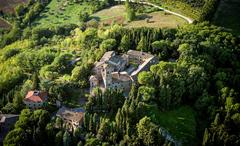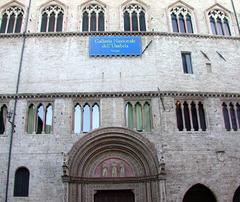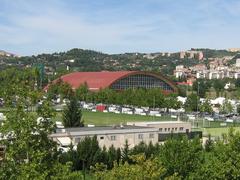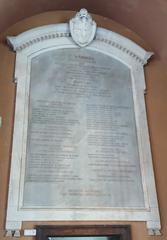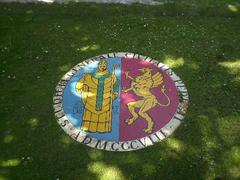Abbazia di San Giustino d’Arna: Visiting Hours, Tickets, and History Guide
Date: 14/06/2025
Introduction
Nestled in the tranquil Umbrian countryside east of Perugia, the Abbazia di San Giustino d’Arna is a remarkable monument to the region’s medieval spiritual, architectural, and cultural heritage. Established before the year 1000 CE, this abbey has witnessed centuries of religious devotion, artistic achievement, and the legacy of chivalric orders such as the Knights Templar and the Knights Hospitaller. Today, it stands as a captivating destination for travelers, history enthusiasts, and pilgrims eager to explore Romanesque architecture, medieval frescoes, and the abbey’s enduring role in shaping local identity.
For those planning a visit, this guide provides an in-depth look at the abbey’s origins, its architectural and artistic highlights, significance within the context of Perugia’s history, and practical advice on visiting hours, ticketing, accessibility, and nearby attractions. Whether your interest lies in sacred art, monastic life, Templar legends, or the serene spirituality of the Umbrian landscape, the Abbazia di San Giustino d’Arna promises an unforgettable journey into Italy’s medieval past.
For more details and planning resources, visit MuseiOnline, Emozioni in Umbria, and Medioevo in Umbria.
Table of Contents
- Introduction
- Historical Overview
- Architectural and Artistic Features
- Religious and Cultural Significance
- Restoration and Conservation
- Visiting Information
- Frequently Asked Questions (FAQ)
- Summary and Recommendations
- References
Historical Overview
Origins and Early Development
The Abbazia di San Giustino d’Arna is one of Umbria’s oldest monastic sites, with the earliest documentary evidence dating to 1156 CE, though archaeological and architectural analysis suggest its foundation may precede the year 1000 (MuseiOnline). Established originally as a Benedictine abbey, it played a central role in the religious and economic life of the region, managing the extensive “Massa d’Arna” agricultural estate and serving as the spiritual center for as many as thirty dependent churches (La Tramontana Perugia).
The Templar and Hospitaller Legacy
The abbey underwent significant transformation in the 13th century when, after a period of decline, Pope Gregory IX entrusted it to the Knights Templar in 1237. The Templars revitalized the site, establishing monastic farms and supporting both local spiritual life and their activities in the Holy Land (Emozioni in Umbria). After the dissolution of the Templar Order in 1312, the abbey passed to the Knights Hospitaller (later the Knights of Malta), who have maintained stewardship over the site into the present day (I Luoghi del Silenzio).
Architectural and Artistic Features
Romanesque Architecture
The abbey church exemplifies the Romanesque style, with solid stone masonry, rounded arches, and a fortress-like presence that harmonizes with the Umbrian landscape (Umbria24). The restored basilica-plan church features a single nave transitioning to a double nave in the presbytery, a raised altar area, a semicircular apse, and a traditional wooden truss ceiling. Outside, a square bell tower stands as both a liturgical and defensive element.
Artistic Heritage: Frescoes and Symbolism
The artistic legacy of San Giustino d’Arna is especially visible in its frescoes:
- Presbytery Fresco: A 15th-century work depicting Saint Justinus’s martyrdom, symbolized by the millstone, shares the Umbrian tradition of devotional art (MuseiOnline).
- Crypt Fresco: The crypt, possibly the oldest part of the abbey, contains a 14th-century Crucifixion scene in the central apse, inspired by the Lorenzetti school of Assisi.
- Templar and Hospitaller Symbolism: Carved crosses, military insignia, and other chivalric emblems incorporated into the stonework testify to the abbey’s unique custodianship under these orders.
Religious and Cultural Significance
Pilgrimage and Monastic Life
The abbey’s location at an important crossroads near Perugia and the route to Gubbio made it a key waystation for medieval pilgrims (Medioevo in Umbria). The Benedictine ethos of “ora et labora” (pray and work) shaped not only the spiritual life of the community but also the agricultural and educational development of the region.
Local Traditions and Legends
San Giustino d’Arna’s history is interwoven with local stories, such as its peaceful resolution of a land dispute with Montelabate Abbey, aided by the prayers of Saint Francis of Assisi (La Tramontana Perugia). This episode reflects the abbey’s role within the broader Franciscan and Benedictine spiritual landscape.
Restoration and Conservation
A major restoration in 1933 stabilized the church and crypt, preserving its Romanesque features and medieval artworks. Conservation efforts have emphasized minimal intervention, allowing visitors to appreciate both the original artistry and the patina of centuries (MuseiOnline).
Visiting Information
Visiting Hours and Tickets
- Hours: The abbey is generally open to the public during special events, such as the annual “Contemplari” festival, and by appointment. Regular worship services are rare. Always check with local tourism offices or the Sovereign Military Order of Malta for current schedules (Emozioni in Umbria).
- Tickets: Entry is typically free during public events, with donations appreciated. Guided tours or special programs may require a modest fee.
Accessibility
Due to its rural setting and historic structure, the abbey has uneven stone floors and limited wheelchair access. Some areas, particularly the crypt, may be difficult for visitors with mobility challenges. Contact the site or tourism office in advance to discuss accessibility (I Luoghi del Silenzio).
Getting There and Travel Tips
- Location: Between Civitella d’Arna and Gualdo, Perugia, Umbria, Italy.
- How to Get There: The abbey is best reached by car; public transportation is limited. The site is approximately 10–15 km from Perugia. Parking is available nearby, followed by a short walk.
- Travel Tip: Visit in spring or autumn for mild weather and vibrant countryside.
Guided Tours and Special Events
Guided tours are occasionally available during festivals or by appointment, offering expert insights into the abbey’s history, art, and architecture. Special events, such as medieval reenactments and agricultural festivals, celebrate the abbey’s traditions and local products (Medioevo in Umbria).
Nearby Attractions
- Chiesa di San Bevignate: A notable Templar church in Perugia, renowned for its medieval frescoes and architecture (Medioevo in Umbria).
- Civitella d’Arna: A picturesque medieval village with panoramic views.
- Perugia Historic Center: Explore the Palazzo dei Priori, National Gallery of Umbria, and vibrant city life.
Frequently Asked Questions (FAQ)
Q: What are the Abbazia di San Giustino d’Arna visiting hours?
A: The abbey is usually open during special events or by appointment. Always confirm with local tourism offices before planning your visit.
Q: Is there an entrance fee?
A: Entry is usually free during public events, with donations welcome. Some guided tours or special events may have a fee.
Q: Is the abbey accessible to visitors with disabilities?
A: Accessibility is limited due to uneven terrain and steps. Inquire in advance about accommodations.
Q: Are guided tours available?
A: Yes, but only during special events or by prior arrangement.
Q: How do I get to the abbey from Perugia?
A: The abbey is best reached by car; limited public transport is available.
Summary and Recommendations
The Abbazia di San Giustino d’Arna is a living testament to Umbria’s spiritual, artistic, and architectural legacy. From its Benedictine origins through its pivotal Templar and Hospitaller periods, the abbey encapsulates centuries of faith, chivalry, and local culture. Although public access is limited, aligning your visit with special events or arranging a guided tour ensures a meaningful experience.
To enrich your journey, explore nearby medieval sites and immerse yourself in the Umbrian countryside. For the latest information on visiting hours, tickets, and tours, consult official resources and consider downloading the Audiala app for comprehensive guides and cultural updates.
Visual and Interactive Resources
- Images: High-resolution photos of the abbey’s Romanesque façade, interior frescoes, and crypt, with descriptive alt text such as “Abbazia di San Giustino d’Arna Romanesque façade” and “15th-century fresco of Saint Justinus martyrdom.”
- Maps: Interactive maps showing the abbey’s location relative to Perugia and nearby attractions.
- Virtual Content: Links to virtual tours or video walkthroughs are available through local tourism portals.
References
- Abbazia di San Giustino d’Arna, 2025, MuseiOnline
- Alla scoperta dei luoghi dei Templari a Perugia, 2025, Umbria24
- Abbazia di San Giustino d’Arna, 2025, Medioevo in Umbria
- Abbazia di San Giustino d’Arna, 2025, Emozioni in Umbria
- I Luoghi del Silenzio: Abbazia di San Giustino d’Arna, 2025
- I Templari a Perugia, 2025, Medioevo in Umbria
- Comune di Perugia Tourism, 2025
